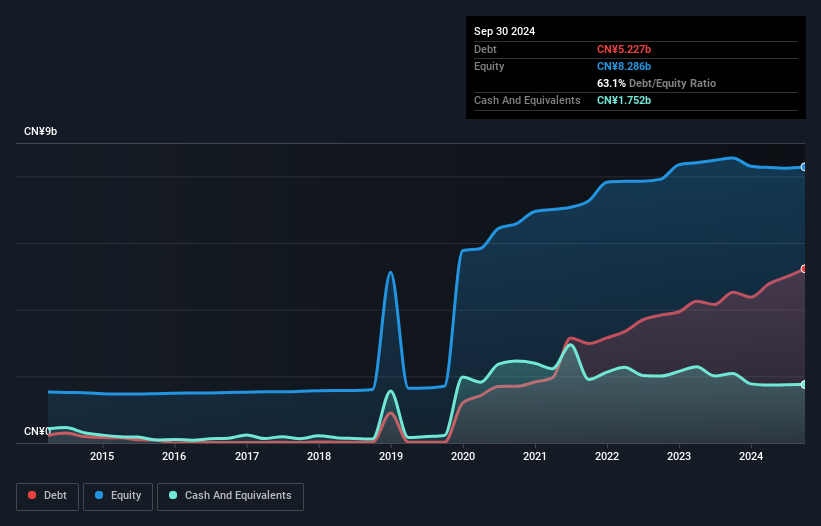Howard Marks put it nicely when he said that, rather than worrying about share price volatility, 'The possibility of permanent loss is the risk I worry about... and every practical investor I know worries about.' When we think about how risky a company is, we always like to look at its use of debt, since debt overload can lead to ruin. As with many other companies Shenzhen Leaguer Co., Ltd. (SZSE:002243) makes use of debt. But is this debt a concern to shareholders?
Why Does Debt Bring Risk?
Debt assists a business until the business has trouble paying it off, either with new capital or with free cash flow. In the worst case scenario, a company can go bankrupt if it cannot pay its creditors. However, a more usual (but still expensive) situation is where a company must dilute shareholders at a cheap share price simply to get debt under control. By replacing dilution, though, debt can be an extremely good tool for businesses that need capital to invest in growth at high rates of return. When we think about a company's use of debt, we first look at cash and debt together.
See our latest analysis for Shenzhen Leaguer
How Much Debt Does Shenzhen Leaguer Carry?
You can click the graphic below for the historical numbers, but it shows that as of September 2024 Shenzhen Leaguer had CN¥5.23b of debt, an increase on CN¥4.52b, over one year. On the flip side, it has CN¥1.75b in cash leading to net debt of about CN¥3.48b.

A Look At Shenzhen Leaguer's Liabilities
The latest balance sheet data shows that Shenzhen Leaguer had liabilities of CN¥2.30b due within a year, and liabilities of CN¥5.64b falling due after that. On the other hand, it had cash of CN¥1.75b and CN¥1.04b worth of receivables due within a year. So it has liabilities totalling CN¥5.15b more than its cash and near-term receivables, combined.
This deficit isn't so bad because Shenzhen Leaguer is worth CN¥9.67b, and thus could probably raise enough capital to shore up its balance sheet, if the need arose. But it's clear that we should definitely closely examine whether it can manage its debt without dilution.
In order to size up a company's debt relative to its earnings, we calculate its net debt divided by its earnings before interest, tax, depreciation, and amortization (EBITDA) and its earnings before interest and tax (EBIT) divided by its interest expense (its interest cover). The advantage of this approach is that we take into account both the absolute quantum of debt (with net debt to EBITDA) and the actual interest expenses associated with that debt (with its interest cover ratio).
Shenzhen Leaguer has a rather high debt to EBITDA ratio of 12.5 which suggests a meaningful debt load. However, its interest coverage of 3.1 is reasonably strong, which is a good sign. Worse, Shenzhen Leaguer's EBIT was down 76% over the last year. If earnings keep going like that over the long term, it has a snowball's chance in hell of paying off that debt. There's no doubt that we learn most about debt from the balance sheet. But you can't view debt in total isolation; since Shenzhen Leaguer will need earnings to service that debt. So when considering debt, it's definitely worth looking at the earnings trend. Click here for an interactive snapshot.
Finally, a company can only pay off debt with cold hard cash, not accounting profits. So the logical step is to look at the proportion of that EBIT that is matched by actual free cash flow. During the last three years, Shenzhen Leaguer burned a lot of cash. While that may be a result of expenditure for growth, it does make the debt far more risky.
Our View
To be frank both Shenzhen Leaguer's conversion of EBIT to free cash flow and its track record of (not) growing its EBIT make us rather uncomfortable with its debt levels. Having said that, its ability to handle its total liabilities isn't such a worry. Taking into account all the aforementioned factors, it looks like Shenzhen Leaguer has too much debt. That sort of riskiness is ok for some, but it certainly doesn't float our boat. There's no doubt that we learn most about debt from the balance sheet. However, not all investment risk resides within the balance sheet - far from it. Case in point: We've spotted 5 warning signs for Shenzhen Leaguer you should be aware of, and 2 of them can't be ignored.
If, after all that, you're more interested in a fast growing company with a rock-solid balance sheet, then check out our list of net cash growth stocks without delay.
New: Manage All Your Stock Portfolios in One Place
We've created the ultimate portfolio companion for stock investors, and it's free.
• Connect an unlimited number of Portfolios and see your total in one currency
• Be alerted to new Warning Signs or Risks via email or mobile
• Track the Fair Value of your stocks
Have feedback on this article? Concerned about the content? Get in touch with us directly. Alternatively, email editorial-team (at) simplywallst.com.
This article by Simply Wall St is general in nature. We provide commentary based on historical data and analyst forecasts only using an unbiased methodology and our articles are not intended to be financial advice. It does not constitute a recommendation to buy or sell any stock, and does not take account of your objectives, or your financial situation. We aim to bring you long-term focused analysis driven by fundamental data. Note that our analysis may not factor in the latest price-sensitive company announcements or qualitative material. Simply Wall St has no position in any stocks mentioned.
About SZSE:002243
Shenzhen Leaguer
Engages in the design, manufacturing, and service provision of plastic packaging solutions for cosmetics, daily necessities, health products, and food in China and internationally.
Proven track record with adequate balance sheet.
Market Insights
Community Narratives



